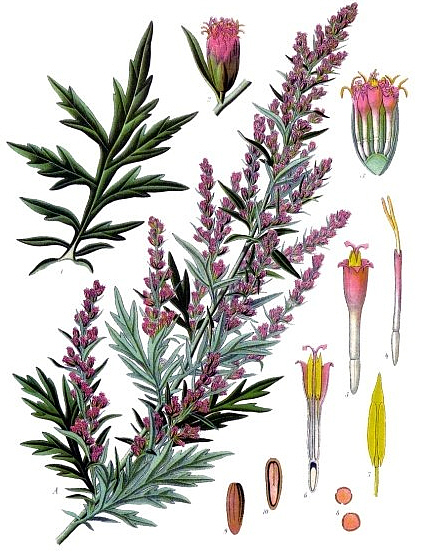

Zitierweise / cite as:
Carakasaṃhitā: Ausgewählte Texte aus der Carakasaṃhitā / übersetzt und erläutert von Alois Payer <1944 - >. -- Anhang A: Pflanzenbeschreibungen. -- Artemisia vulgaris L. -- Fassung vom 2007-07-27. -- URL: http://www.payer.de/ayurveda/pflanzen/artemisia_vulgaris.htm
Erstmals publiziert: 2007-07-27
Überarbeitungen:
Anlass: Lehrveranstaltung SS 2007
©opyright: Dieser Text steht der Allgemeinheit zur Verfügung. Eine Verwertung in Publikationen, die über übliche Zitate hinausgeht, bedarf der ausdrücklichen Genehmigung des Verfassers
Dieser Text ist Teil der Abteilung Sanskrit von Tüpfli's Global Village Library
Falls Sie die diakritischen Zeichen nicht dargestellt bekommen, installieren Sie eine Schrift mit Diakritika wie z.B. Tahoma.
Verwendete und zitierte Werke siehe: http://www.payer.de/ayurveda/caraka0001.htm

Abb.: Artemisia vulgaris L.
= Gewöhnlicher Beifuß
[Bildquelle: Koehler]
Drury:
"Artemisia Indica (Willd.) N. O. Compositae. Majtari, Mastaru, Hind. Machipattiri,Tam. Machipatri, Tel. Tiru-nitripachha, MAL. Mastam, Beng.
Description.—Suffruticose, erect; leaves white, tomentose below, pinnatifid, upper ones trifid, uppermost and branched ones undivided, and with the lobes oblong, obtuse, mucronate; capitules spicately panicled oblong, panicle leafy and spreading, younger racemes nodding ; outer scales of the younger pubescent involucre leafy, acute, of the inner ones scariose, obtuse; flowers small, greenish white. Willd. Sp. iii. 1846.—Roxb. Flor. Ind. iii. 449.—Rheede, x. t. 45.—A. grata, Dec.-------Common on high lands. Mysore.
Medical Uses.—The strong aromatic odour and bitter taste of this plant indicate tonic and stomachic properties. Dr Wight states that the leaves and tops are administered in nervous and spasmodic affections connected with debility, and also that an infusion of them is used as a fomentation in phagedenic ulceration. Dr L. Stewart describes an infusion of the tops and leaves as a mild stomachic tonic.—(Pharm. of India.) All the different species of Artemisia are aromatic bitter tonics, and most of them have anthelmintic properties. They contain an essential oil, a bitter principle called Absinthine, and a peculiar acrid. They are principally used, in intermittent fevers and dyspepsia, also in epilepsy and chorea. The present species is used as an antispasmodic in hysteria. It might be used as a substitute for Cinchona, though inferior in intermittent fevers.—Powell's Punj. Products."
[Quelle: Drury, Heber <1819 - 1872>: The useful plants of India : with notices of their chief value in commerce, medicine, and the arts. -- 2d ed. with additions and corrections. London : Allen, 1873. -- xvi, 512 p. ; 22 cm. -- s.v.]